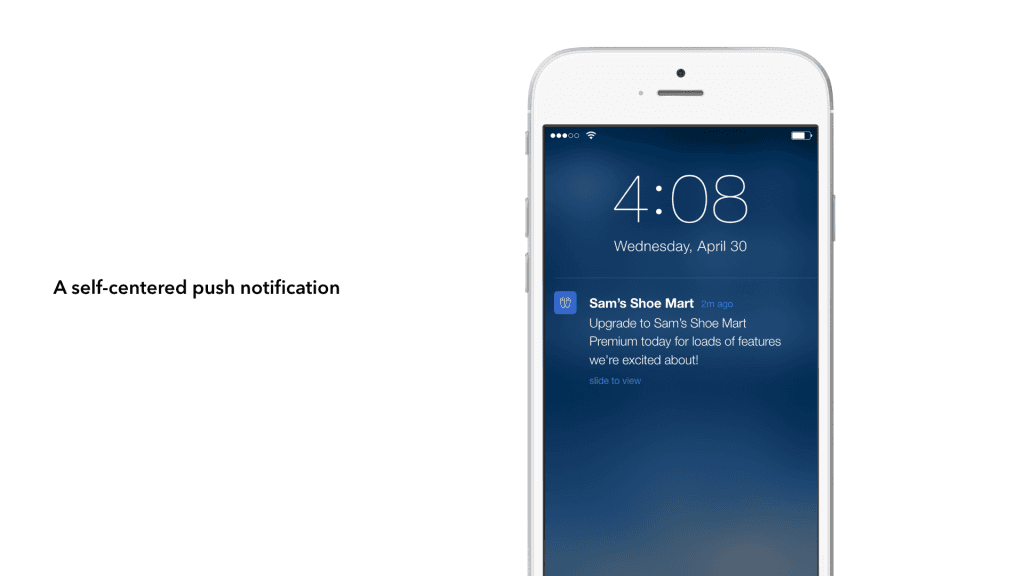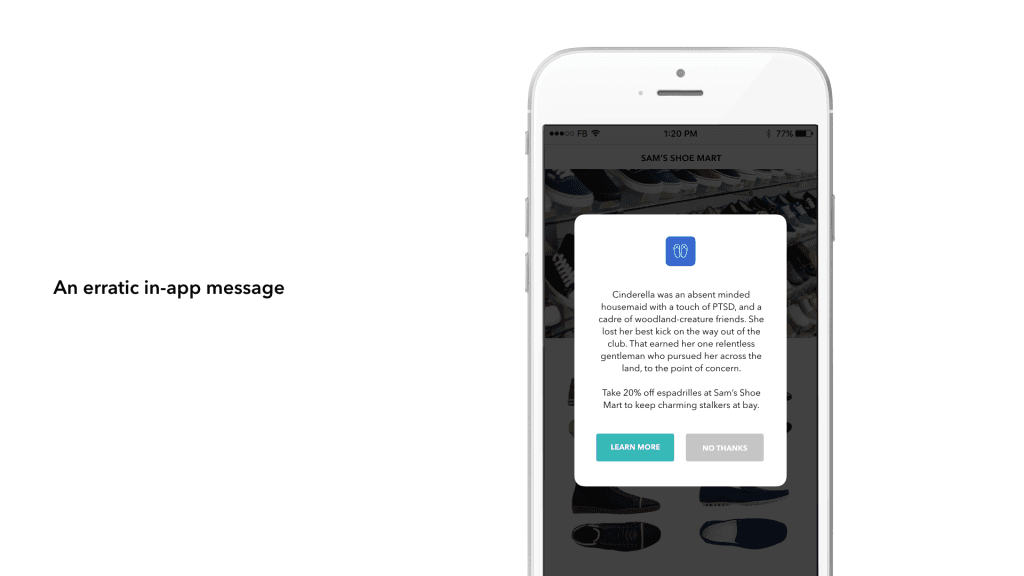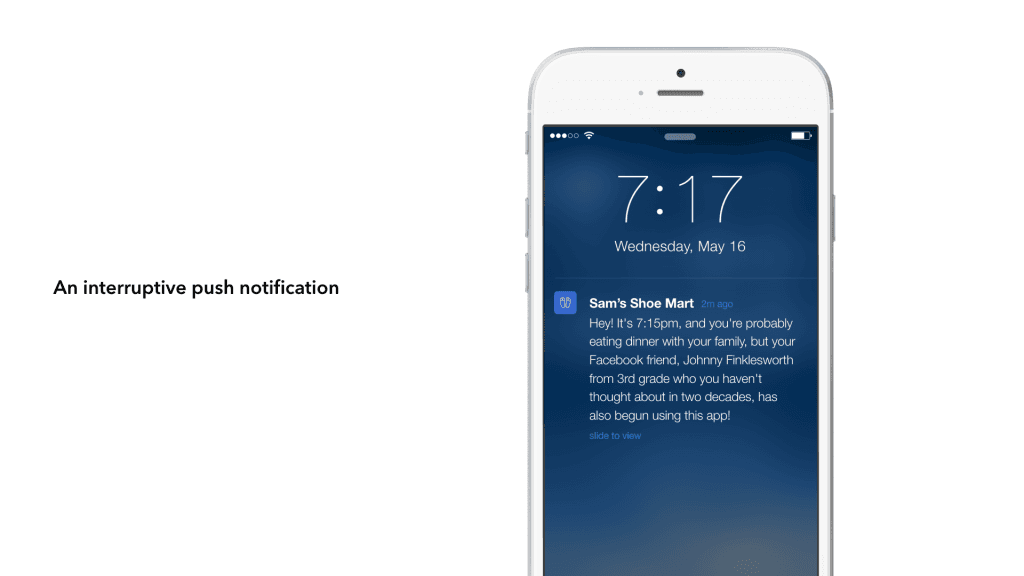If Mobile Marketing is a Holiday Party, Don’t be “That Guy”
Published on December 04, 2015/Last edited on December 04, 2015/6 min read


Team Braze
If your mobile marketing personality were represented by someone at a holiday party, who would they be? And more importantly––would you want to talk with them?
Let’s set the scene. You walk into your company’s holiday mixer, scanning the room for the person or people you most want to hang out with. But there are some bad actors, right off the bat, who are the first people you want to avoid.
The least attractive personalities at the party
Jason holds court near the hot wings. He’s found some success this year with his new launch, but he’s really quite a bore. He’s self obsessed, and speaks too loudly. Most avoid him, and mingle elsewhere in search of more accessible conversationalists.
Jennifer might have had a bit too much to drink. As others draw near, she alternates between ribald slapstick and non-sequiturs. She doesn’t seem to know who she is, or how to be herself. She’s messy, inconsistent, and no one can be sure what she’s really about.
Ethan is doe-eyed. He finds it all to be too much. He lurks on the edges of conversation clusters, dropping a few one-liners here and there, but most are ill-received. Unsuccessful, he moves to the periphery. He’s invisible, and easy to overlook.
All three of these personalities have marketing counterpoints
Jason: self-centered marketing
Self-obsessed Jason is impressed with his own success, and wants to make sure everyone else is, too. He doesn’t converse, he lectures. He certainly doesn’t express interest in his peers, and when they try to participate, he doesn’t listen.

At a holiday party, in marketing, and in life, one of the least likeable traits is self-centeredness. Hemingway said: “When people talk, listen completely. Most people never listen.”
In a piece called “Does Your Content We-We All Over Itself?” Bruce McDuffee, founder of Knowledge Marketing for Industry, stresses that “the first thing effective content marketers learn is to get over themselves.” The piece goes on to say that great marketers “know the content they create is about the pain or passion in the people who comprise their target audience,” not about their own pain or passion.
How to diagnose self-centered marketing
Are you enamored with your own story? Do you spend a good deal of time talking about your organization and your process? Do you over employ the words “we,” “us,” and “our” in your marketing content? Do you often attempt to guide your customers into taking certain actions without making clear what the value of taking those actions will be for them?
One simple remedy
Begin by polling your customers! If you’re lucky enough to have a solid following with active social engagement, pay attention to what your customers and users are already saying.
If you’re still building your audience, follow your target users on social media. See what they’re talking about outside of the context of your product. What’s your community into? What drives them?
Now, where does your app or brand fit into their lives? How do you solve their problems? How do you make their lives easier or better?
Once you’ve done some listening to figure these things out, shift the focus from your needs (win the customer!) to their needs (solve their problem!). How can you put the user or customer first?
Jennifer: erratic, inauthentic marketing
Have you ever read a piece of marketing that tries so hard to “have a voice,” their analogies and references begin to lose all meaning?

The above example might work for a site that has a very quirky personality (and if this is the voice you’ve naturally cultivated for your brand, go for it, and don’t hold back), but if you find yourself trying to emulate this over-the-top voice, or any other that’s just not “you,” that artifice will come through. Your target audience will know better. Nobody likes a phony.
How to diagnose erratic, inauthentic marketing
Does your marketing message come from an array of disjointed, inconsistent points of view? Do you forsake an editorial calendar, and instead tend toward intermittent bursts of inspiration? Do you fling best-guess marketing attempts at your users, hoping something will stick?
One simple remedy
Get to know your marketing voice. Create a persona, and give him or her a name, a job, even an outfit. Where does he or she shop? What sort of education have they had? What’s their favorite magazine? You don’t have to share all these details with your audience. You just need to know it in house so that your marketing always comes from a consistent source.
Ethan: socially awkward marketing
Chances are, poor Ethan shows up to his community outreach the same way he shows up to a party. He is at first an unwanted interruption–like a notification that interrupts gameplay with a sales pitch. Later, he’s silent and forgotten–once a user gets annoyed with your notifications, they’ll simply turn them off.
How useful is a push notification that comes at the wrong time and with information you don’t need?

How to diagnose socially awkward marketing
Have you allowed your knowledge of current trends to lapse? Have you lost touch with what feels good to users, versus what adds unnecessary noise to their lives? Do you lack strategy around the timing and specificity of your messaging?
One simple remedy
Our own Mark Ghermezian, CEO and co-founder of Appboy, shared on VentureBeat that “50-70 percent of users are turning off push notifications on their phones.” It doesn’t take rocket science to see why. Just think about why you’ve shut off your own push notifications. They’re usually impersonal interruptions, devoid of context and timing.
If 50-70% are opting out, that means 30-50% remain opted in. To keep your users in the latter group, use messaging that’s contextually relevant and adds value.
For example, if a user has browsed and browsed, but never made a purchase, shoot them a message during app use that offers them a personalized reward or discount that encourages that first purchase on the items they’re browsing most frequently.
Get to know how users move through your app. Use your messaging to enhance their experience, rather than interrupt it. This will require thinking about your strategy before sending any message. Focus with intention on where you’ll have the most impact.
Be the one who gets invited back to the party
Think of the sorts of people who are great at parties.
They have natural intuition and good timing. They’re helpful and maybe even generous, without being overly solicitous. They’re in the vanguard, but low-key and humble.
They tend to be great listeners, fully engaged with the people around them. They don’t pantomime interest. They’re genuine. They move easily through the crowd till they find the right people, and are able to settle effortlessly into conversation.
Holiday season or not, a real-life social situation is a great barometer against which to weigh your marketing strategy. When in doubt about your marketing approach, you can always ask yourself, “If this were a party, would I be invited back?”
Be Absolutely Engaging.™
Sign up for regular updates from Braze.
Related Content
View the Blog
Look out: Outlook's new email requirements and what they mean for Braze senders

Alison Gootee

How the Braze Data Platform enhances flexibility and fosters collaboration

Sahiz Kaur

Customer churn prediction: Using data for smarter retention
